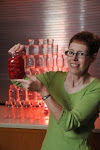 Let's look at the glass. Most of the beads of water on the glass will be at and below the level of the ice water in the glass. Since there's water on the inside and water on the outside, and both are at the same level, a reasonable person could reasonably think that perhaps somehow the glass is letting cold water leak through from the inside to the outside.
Let's look at the glass. Most of the beads of water on the glass will be at and below the level of the ice water in the glass. Since there's water on the inside and water on the outside, and both are at the same level, a reasonable person could reasonably think that perhaps somehow the glass is letting cold water leak through from the inside to the outside.So let's test that idea, and some of its competing cousins, with one of the most powerful power tools ever invented by humanity. To me, that most powerful of power tools is two words: "if" and "then". Using "If, then" thinking and "if, then" speaking helps us to draw predictions from possibilities, and we can test those predictions to see if the possibilities hold water.
If the water on the outside has oozed through the glass from the water on the inside, then an empty glass at the same temperature as the glass of ice water should not sweat.
Let's try a fair comparison between two glasses. Working indoors, what if you fill halfway two identical glasses with ice-water. Let the glasses stand for a minute to let the ice water cool off the glasses. Then pour out the water from one glass and carry both glasses outside. Do both glasses begin to sweat? If the water is "oozing" through the glass, then how do droplets form on the glass that you emptied?
Let's try another fair comparison. Fill a small glass tumbler half full with vegetable oil. Leave another similar tumbler empty. Put both in the freezer for a couple of hours. Then take the two glasses out into the heat and humidity of the backyard. If you can, also bring along a third tumbler that you've filled half full with ice water, and a fourth tumbler half full of warm tap water.
If the beads of sweat that form on the glass outside are from water oozing through the glass, then you would not expect the cold glass with the cold vegetable oil to form any beads of water. What happens to the four glasses?
Based on these experiments and others that you may come up with on your own, which idea holds water better: the idea that water is oozing through the glass, or the idea that a cold glass (no matter how you make it cold) will condense droplets of water when you put it out in humid air?
Water is important to health in many ways, and in these hot days, one key way is that when water vapor condenses on a cold object, the condensing tends to warm up the thing on which the water vapor condensed and formed droplets.
And in turn, when water droplets on a thing evaporate, the evaporation tends to cool the thing from which the water evaporated. In our case, the physiologically complex process of sweating uses a pretty simple process of evaporative cooling. The best part is you can drink the data.
Thomas M. Zinnen, UW-Extension Biotechnology Specialist
You can get some first-hand insights into heating and cooling by using the glass of ice-water that can both cool you off and let you test some cool ideas.
Or you can schedule a training session in your community and I'd be happy to come and help lead the explorations. Food is familiar, accessible, inexpensive and safe, so it's great for hands-on explorations into experimentation. Plus, you get to eat (and sometimes drink) the data!




No comments:
Post a Comment